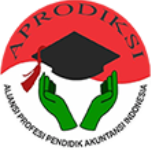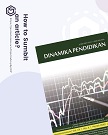Negotiation Competencies Based on Assertiveness and Self Efficacy for Vocational High School Students
(1) Universitas Muhammadiyah Purwokerto
(2) Universitas Negeri Semarang
(3) Universitas Muhammadiyah Purwokerto
Abstract
This study aims to determine the association of assertiveness, self efficacy with the competency of negotiations for students. The study was conducted in State Vocational School 1 Bawang Banjarnegara involving 132 samples in Study Program of Online Marketing Business. Sampling technique was stratified random sampling, and data collection technique used questionnaire instruments. Data were analyzed through correlation technique data of product moment. Based on hypothesis testing, results can be obtained that assertiveness had a positive relationship with negotiation competencies. Similarly, self efficacy also had a positive relationship to negotiation competencies; these two independent variables also had a positive and significant relationship to negotiation competencies. The implications of the results of this study were that the negotiation competencies for students can support careers in marketing so that it required the formation of assertiveness and an increase in self-efficacy in the learning process.
Keywords
Full Text:
PDFReferences
Amat, S., & Mahmud, Z. (2009). Hubungan antara Ketegasan Diri dan Kepuasan Hidup dalam Kalangan Pelajar Institusi Pengajian Tinggi. Jurnal Pendidikan Malaysia, 34(2), 49–65. Retrieved from http://journalarticle.ukm.my/223/1/1.pdf
Bandura, A. (1991). Handbook of Moral Behavior and Development. In W. M. Kurtines & J. L. Gewirtz (Eds.), Handbook of Moral Behavior and Development (Vol. I, pp. 45–103). New York: Hillsdale.
Bandura, A. (2009). Self Efficacy in Changing Societes. New York: Cambridge University Press.
Choi, S., & Kim, D. (2010). The Relations between Social Skills and Aggressive Behavior by Types of Bystandares’ Roles. The Korean Juornal of Youth Counseling, 18(1), 59–72.
Deng, Y. Gang, Di, H. shuang, & Misra, R. D. K. (2018). On significance of initial microstructure in governing mechanical behavior and fracture of dual-phase steels. Journal of Iron and Steel Research International, 25(9), 932–942. https://doi.org/10.1007/s42243-018-0133-0
Elliott, S. N., & Gresham, F. M. (1987). Children’s social skills: Assessment and classification practices. Journal of Counseling and Development, 66, 96–99.
Gallois, K., & Wilson, C. (1993). Assertion and Its Social Contexs. Oxford: Pergamon Press Ltd.
Golden, M. (1978). A Suggested Measure of Cognition Within the Context of Assertion. Concordia University Montreal, Quebec.
Goulão, M. de F. (2014). The Relationship between Self-Efficacy and Academic Achievement in Adults’ Learners. Athens Journal of Education, 1(3), 237–246.
Hamdan, Y., Ratnasari, A., & Hirzi, A. T. (2017). Profil Negosiator Bisnis Wanita Pengusaha. MIMBAR, Jurnal Sosial Dan Pembangunan, 29(2), 235. https://doi.org/10.29313/mimbar.v29i2.401
Hartman, G. M. (1997). Seni Negoisasi (Tips Negoisasi yang Gemilang). Jakarta: Gramedia.
Johnson, W. ., & Johnson, F. P. (2009). Joining Together 10th Edition Group Theory and Group Skills. New Jersey: Pearson Education.
Kisti, H. H., & Fardana, N. A. (2012). Hubungan Antara Self Efficacy dengan Kreativitas Pada Siswa SMK. Jurnal Psikologi Klinis Dan Kesehatan Mental, 1(02), 52–58.
Lange, A. J. and J. (1976). Responsible assertive behavior : cognitive/behavioral procedures for trainers. Patricia and McGovern, Thomas V. Retrieved from https://trove.nla.gov.au/work/10934057
Little, S. G., Swangler, J., & Akin-Little, A. (2017). Defining Social Skils. In J. L. Matson (Ed.), Handbook of Social Behavior and Skills in Children, Autism and Child Psychopathology Series (pp. 9–17). New York. https://doi.org/10.1007/978-3-319-64592-6
Maryani, E. (2011). Pengembangan Program Pembelajaran IPS untuk Peningkatan Keterampilan Sosial. Bandung: Alfabeta.
Milam, L. A., Cohen, G. L., Mueller, C., & Salles, A. (2019). The Relationship Between Self-Efficacy and Well-Being Among Surgical Residents. Journal of Surgical Education, 76(2), 321–328. https://doi.org/https://doi.org/10.1016/j.jsurg.2018.07.028
Monika, A. (2017). Peran Efikasi Diri dan Motivasi Belajar dalam Meningkatkan Hasil Belajar Siswa Sekolah Menengah Kejuruan. Jurnal Pendidikan Manajemen Perkantoran, 1(1), 110–117.
Nelson, D. B., & Nelson, K. W. (2003). Emotional Intelligence Skills: Significant Factors in Freshmen Achievement and Retention. In American Counseling Association Conference (2003) 20p. https://doi.org/(ED 476121)
Omrod, J. E. (2009). Psikologi Pendidikan Jilid 1. Jakarta: Erlangga.
Perera, H. N., Calkins, C., & Part, R. (2019). Teacher Self-Efficacy Profiles: Determinants, Outcomes, and Generalizability across Teaching Level. Contemporary Educational Psychology. https://doi.org/https://doi.org/10.1016/j.cedpsych.2019.02.006
Poyrazli, S., et al. (2002). Relation between assertiveness, academic self-efficacy, and psychosocial adjustment among international graduate students. Journal of College Student Development, 43(5), 632–642.
Poyrazli, S. (2000). The role of assertiveness, academic experiences, and academic self- efficacy on psychosocial adjustment of graduate international students. University of Houston.
Purwanto, D. (2002). Komunikasi Bisnis. Jakarta: Erlangga.
Rakos, R. F. (1991). Asssertive Behavior: Theory, Research and Traning. New Yor: Routledge.
Schunk, D. H. (1991). Self-efficacy and academic motivation. Educational Psychologist, 26 (3-4), 207–231. https://doi.org/10.1207/s15326985ep2603&4_2
Sert, A. . (2003). The Effect of an Assertiveness Training on the Assertiveness and Self-Esteem Level of 5th Grade Children. Middle East Technical University.
Sihaloho, L., Rahayu, A., & Wibowo, L. A. (2018). Pengaruh Metakognitif Terhadap Hasil Belajar Pada Mata Pelajaran Ekonomi Melalui Efikasi Diri Siswa. Jurnal Ekonomi Pendidikan Dan Kewirausahaan, 6(2), 121. https://doi.org/10.26740/jepk.v6n2.p121-136
Sivin-Kachala, J., & Bialo, E. (2009). IESD Comprehensive Technical Report, Evaluation of the Social Skills of Full-Time, Online Public School Students. New York: Interactive Educational System Design (IESD) Inc.
Sriyanto, Karim, A. A., Zaenul, A., & Maryani, E. (2014). Perilaku Asertif dan Kecenderungan Kenakalan Remaja Berdasarkan Pola Asuh dan Peran Media Massa. Jurnal Psikologi ISSN:2460 867X (Online) ISSN:0215-8884 (Print), 41(1), 74–88. https://doi.org/https://doi.org/10.22146/jpsi.6959
Sriyanto, S., & Novianto, V. (2018). SEM Application to Investigate Social Studies Learning and Mass Media Impacts on Assertive Behavior and Juvenile Delinquency. Advanced Science Letters, 24(1), 154–158. https://doi.org/doi:10.1166/asl.2018.11944
Sue, D. W., & Sue, D. (1990). Counseling the Culturally Different. New York: John Wiley & Sons.
Tuhardjo, Juliardi, D., & Rafsanjani, A. M. (2016). The Effect of Learning Effectiveness and Self-Efficacy on Intermediate Financial Accounting I Learning outcome. Journal Of Humanities And Social Science, 21(9), 1–9. https://doi.org/doi: 10.9790/0837-2109080109
Utami, L. H., & Nurjati, L. (2018). Hubungan Self-Efficacy, Belief dan Motivasi dengan Kecemasan Mahasiswa dalam Pembelajaran Bahasa Inggris. Psympathic : Jurnal Ilmiah Psikologi, 4(2), 219–238. https://doi.org/10.15575/psy.v4i2.1447
Uyun, Q., & Hadi, S. (2005). Pelatihan Asertivitas untuk Meningkatkan Ketahanan Isteri terhadap Tindak Kekerasan Suami. SOSIOSAINS, 18(Januari).
Winkel, W. S. (2009). Psikologi Pengajaran. Yogyakarta: Media Abadi.
Yadak, S. M. A. (2017). The Impact of the Perceived Self-Efficacy on the Academic Adjustment among Qassim University Undergraduates. Open Journal of Social Sciences, 05(01), 157–174. https://doi.org/10.4236/jss.2017.51012
Ying, C. J., & Yi, L. J. (n.d.). Social Skills in Children with Special Needs, With and Without Mainstream Education in Singapore. Singapore: National Institute of Education, Nanyang Technological University.
Refbacks
- There are currently no refbacks.

This work is licensed under a Creative Commons Attribution 4.0 International License.

.png)

.png)





